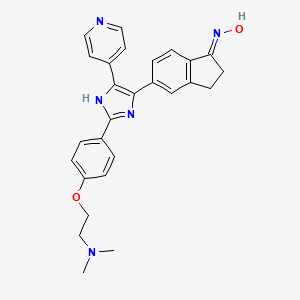Drug Information
Drug (ID: DG01667) and It's Reported Resistant Information
| Name |
SB590885
|
||||
|---|---|---|---|---|---|
| Synonyms |
SB590885; 405554-55-4; SB-590885; 5-(2-(4-(2-(dimethylamino)ethoxy)phenyl)-5-(pyridin-4-yl)-1H-imidazol-4-yl)-2,3-dihydro-1H-inden-1-one oxime; SB 590885; (NE)-N-[5-[2-[4-[2-(dimethylamino)ethoxy]phenyl]-5-pyridin-4-yl-1H-imidazol-4-yl]-2,3-dihydroinden-1-ylidene]hydroxylamine; (E)-5-(2-(4-(2-(dimethylamino)ethoxy)phenyl)-5-(pyridin-4-yl)-1H-imidazol-4-yl)-2,3-dihydro-1H-inden-1-one oxime; (E)-SB-590885; (Z)-SB-590885; SCHEMBL131578; CHEMBL477989; SCHEMBL12518520; SCHEMBL16111665; SCHEMBL17378611; EX-A612; CHEBI:131881; BCPP000070; 1H-Inden-1-one, 5-[2-[4-[2-(dimethylamino)ethoxy]phenyl]-5-(4-pyridinyl)-1H-imidazol-4-yl]-2,3-dihydro-, oxime; 5-[2-[4-[2-(Dimethylamino)ethoxy]phenyl]-5-(4-pyridinyl)-1H-imidazol-4-yl]-2,3-dihydro-1H-inden-1-one oxime; AMY20674; BDBM50457452; NSC754362; NSC756456; s2220; SB-590885 (RAF); ZINC100061199; CCG-264947; NSC-754362; NSC-756456; (E)--(2-(dimethylamino)ethoxy)phenyl)-5-(pyridin-4-yl)-1H-imidazol-4-yl)-2,3-dihydro-1H-inden-1-one oxime; (E)-SB590885; AS-16232; (E)-SB 590885; A25514; J-501805; BRD-K78809024-001-05-7; Q27120375; Q27225284; (1E)-N-{5-[2-{4-[2-(dimethylamino)ethoxy]phenyl}-4-(pyridin-4-yl)-1H-imidazol-5-yl]-2,3-dihydro-1H-inden-1-ylidene}hydroxylamine; 5-[2-[4-[2-(Dimethylamino)ethoxy]phenyl]-5-(4-pyridinyl)-1H-imidazol-4-yl]-2,3-dihydro-1H-inden-1-one oxime;SB-590885
Click to Show/Hide
|
||||
| Structure |

|
||||
| Target | . | NOUNIPROTAC | [1] | ||
| Click to Show/Hide the Molecular Information and External Link(s) of This Drug | |||||
| Formula |
7
|
||||
| IsoSMILES |
CN(C)CCOC1=CC=C(C=C1)C2=NC(=C(N2)C3=CC=NC=C3)C4=CC5=C(C=C4)/C(=N/O)/CC5
|
||||
| InChI |
InChI=1S/C27H27N5O2/c1-32(2)15-16-34-22-7-3-19(4-8-22)27-29-25(18-11-13-28-14-12-18)26(30-27)21-5-9-23-20(17-21)6-10-24(23)31-33/h3-5,7-9,11-14,17,33H,6,10,15-16H2,1-2H3,(H,29,30)/b31-24+
|
||||
| InChIKey |
MLSAQOINCGAULQ-QFMPWRQOSA-N
|
||||
| PubChem CID | |||||
Type(s) of Resistant Mechanism of This Drug
Drug Resistance Data Categorized by Their Corresponding Diseases
ICD-02: Benign/in-situ/malignant neoplasm
| Drug Sensitivity Data Categorized by Their Corresponding Mechanisms | ||||
|
|
||||
| Key Molecule: Serine/threonine-protein kinase B-raf (BRAF) | [2] | |||
| Molecule Alteration | Missense mutation | p.V600E (c.1799T>A) |
||
| Sensitive Disease | Solid tumour/cancer [ICD-11: 2A00-2F9Z] | |||
| Experimental Note | Revealed Based on the Cell Line Data | |||
| In Vitro Model | HEK293 cells | Kidney | Homo sapiens (Human) | CVCL_0045 |
| Ba/F3 cells | Colon | Homo sapiens (Human) | CVCL_0161 | |
| In Vivo Model | Nude mouse xenograft model | Mus musculus | ||
| Experiment for Molecule Alteration |
BRAF kinase assay | |||
| Experiment for Drug Resistance |
Flow cytometry assay | |||
| Mechanism Description | The missense mutation p.V600E (c.1799T>A) in gene BRAF cause the sensitivity of SB590885 by aberration of the drug's therapeutic target | |||
| Drug Sensitivity Data Categorized by Their Corresponding Mechanisms | ||||
|
|
||||
| Key Molecule: Serine/threonine-protein kinase B-raf (BRAF) | [1] | |||
| Molecule Alteration | Missense mutation | p.V600E (c.1799T>A) |
||
| Sensitive Disease | Melanoma [ICD-11: 2C30.0] | |||
| Experimental Note | Identified from the Human Clinical Data | |||
| In Vitro Model | SW1736 cells | Thyroid | Homo sapiens (Human) | CVCL_3883 |
| 8505C cells | Thyroid | Homo sapiens (Human) | CVCL_1054 | |
| Hth104 cells | Thyroid gland | Homo sapiens (Human) | CVCL_A427 | |
| In Vivo Model | mouse xenograft model | Mus musculus | ||
| Mechanism Description | The missense mutation p.V600E (c.1799T>A) in gene BRAF cause the sensitivity of SB590885 by aberration of the drug's therapeutic target | |||
References
If you find any error in data or bug in web service, please kindly report it to Dr. Sun and Dr. Zhang.
